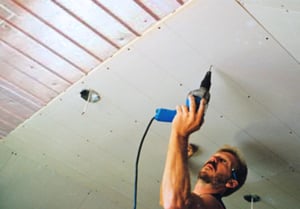Why Radiant Ceiling and Wall Heating Is an Excellent Choice for Your Home
 Hydronic radiant ceiling heating has some very real advantages, yet it has often succumbed to the marketing of “warm floors” by the radiant industry.
Hydronic radiant ceiling heating has some very real advantages, yet it has often succumbed to the marketing of “warm floors” by the radiant industry.
Radiant ceiling heating dodges design issues about floor heights and transitions and compatibility with floor goods.
Radiant floors are only very warm when there is a big heating load on the coldest winter nights. Radiant ceilings do “see” the floor, making the floors feel neutral via the gentle radiation from above. It also can be a savior in very high heat loss “trophy” rooms where the floor just can’t do it.
Benefits of Radiant Ceiling Heat Panels
As the demand for flexible and efficient heating grows, many homeowners are turning to radiant ceiling heat as a smart alternative to floor-based systems. These systems offer all the comfort of radiant warmth without disrupting flooring design or layout.
Radiant ceiling heating systems are especially useful in homes with limited floor space or specific flooring materials. With radiant ceiling panels, heating elements are mounted overhead, making them invisible, efficient, and perfect for modern interiors.
Why Choose Radiant Heating in Ceiling Spaces?
a. Quick and even heat distribution throughout the room
b. No interference with floor coverings or furniture
c. Improved energy efficiency due to lower water temperatures
d. Ideal for renovations and new builds alike
Whether you are using radiant ceiling heat panels in a single room or across an entire home, this type of radiant heating ceiling system ensures comfort with minimal maintenance. Plus, ceiling-mounted radiant heating panels are easy to integrate with modern thermostats and zoning controls, giving homeowners full command over their comfort.
Radiant Ceiling Heating is More Efficient than Floor Heating
Also, radiant ceiling panels are more efficient than floor heating. A radiant ceiling has the minimal heat resistance of 5/8” sheetrock, while floors can have significant resistance to overcome with flooring goods and furniture.
An Ecowarm radiant heating ceiling can typically operate in water temperature ranges of 80F-95F, while Ecowarm radiant floors will often operate in the 95f–120F temperature range.
The lower the supply water temperature, the more efficient a system is. This application is not for every radiant project, but keep it in your design tool box.

 Hydronic radiant ceiling heating has some very real advantages, yet it has often succumbed to the marketing of “warm floors” by the radiant industry.
Hydronic radiant ceiling heating has some very real advantages, yet it has often succumbed to the marketing of “warm floors” by the radiant industry.
